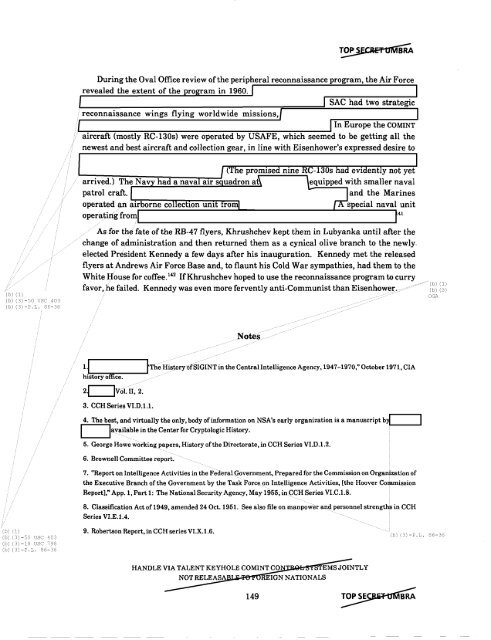American Cryptology during the Cold War - The Black Vault
American Cryptology during the Cold War - The Black Vault
American Cryptology during the Cold War - The Black Vault
Create successful ePaper yourself
Turn your PDF publications into a flip-book with our unique Google optimized e-Paper software.
During <strong>the</strong> Oval Office review of<strong>the</strong> peripheral reconnaissance program, <strong>the</strong> Air Force<br />
revealed <strong>the</strong> extent of <strong>the</strong> ro am in 1960.<br />
SAC had two strategic<br />
reconnaissance wings flying worldwide missions,<br />
In Europe <strong>the</strong> COMINT<br />
.L.-......-.",.........-.,....."="",....,,.,,...,,...,..-----....,..,.........,,.,,.,,,...~=_.....,,...,... ......--...<br />
aircraft (mostly RC-130s) were operated by USAFE, which seemed to be getting all <strong>the</strong><br />
newest and best aircraft and collection gear, in line with Eisenhower's expressed desire to<br />
Ib) (1)<br />
Ib) (3) -50 USC 403<br />
Ib) (3) -P.L. 86-36<br />
As for <strong>the</strong> fate of<strong>the</strong> RB-47 flyers, Khrushchev kept <strong>the</strong>m in Lubyanka until after <strong>the</strong><br />
change of administration and <strong>the</strong>n returned <strong>the</strong>m as a cynical olive branch to <strong>the</strong> newly,<br />
elected President Kennedy a few days after his inauguration. Kennedy met <strong>the</strong> released<br />
flyers atAndrews Air Force Base and, to flaunt his <strong>Cold</strong> <strong>War</strong> sympathies, had <strong>the</strong>m to <strong>the</strong><br />
White House for coffee. 142 IfKhrushchev hoped to use <strong>the</strong> reconnaissance program to curry<br />
favor, he failed. Kennedy was even more fervently anti-Communist than Eisenhower,<br />
(b) (1)<br />
Ib) (3)<br />
OGA<br />
Notes<br />
1.1~ ~ ...I~Th~liistOryOrSIGINTin <strong>the</strong> Central Intelligence Agency, 1947-1970," October 1971, CIA<br />
history office.<br />
2c:::::::JvoCII, 2.<br />
3. CCH Series VI.D.l.1.<br />
4. <strong>The</strong> best, and virtually <strong>the</strong> only, body ofinformation on NSA's early organization is a manuscript b~<br />
I laya.ilabie in <strong>the</strong> Center for Cryptologic History. L...-__<br />
5. George Howe working papers, History of<strong>the</strong> Directorate, in CCH Series VI.D.l.2.<br />
6. Brownell Committee report.<br />
7. "Report on Intelligence Activities in <strong>the</strong> Federal(}overnment, Preparedfor <strong>the</strong> Commission on Organizationof<br />
<strong>the</strong> Executive Branch of<strong>the</strong> Government by <strong>the</strong> Task Ftlrceon Intelligence Activities, [<strong>the</strong> Hoover Commission<br />
Report]," App.l, Part 1: <strong>The</strong> National Security Agency, May 1955,inCCH Series VI.C.1.8.<br />
8. Classification Act of1949, amended 24 Oct. 1951. See also file on manpowerall,d personnel strengths in CCH<br />
Series VI.E.1.4.<br />
Ib) (1)<br />
Ib) (3) -50 USC 403<br />
Ib) (3) -18 USC 798<br />
Ib) (3) -P.L. 86-36<br />
9. Robertson Report, inCCH series VLX.1.6.<br />
Ib) (3) -P.L. 86-36<br />
HANDLE VIA TALENT KEYHOLE COMINTCO<br />
EMS JOINTLY<br />
RUUlf\'1l'l"rnRE~IGNNATIONALS<br />
149
















